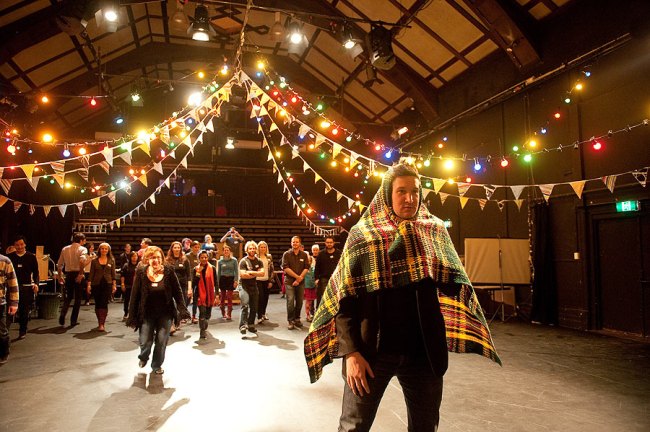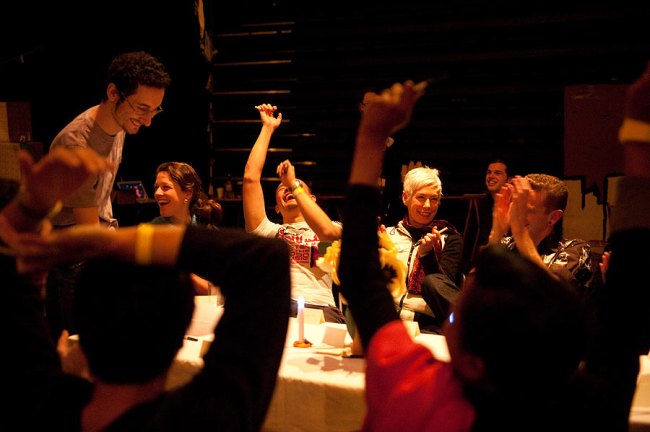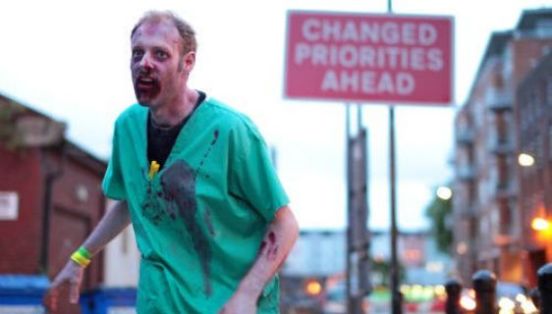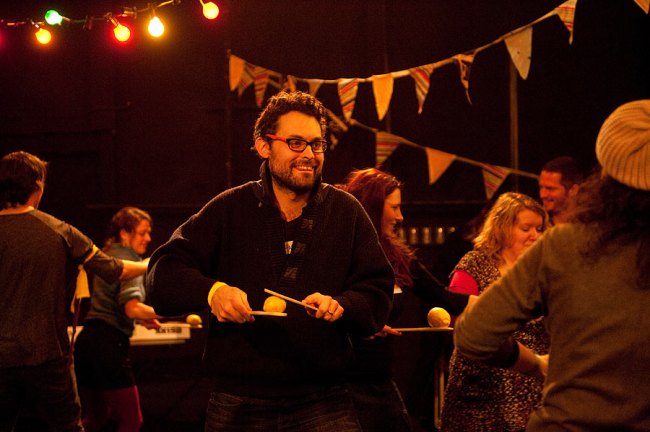Programming note: I love interviewing couples. I barely have to speak and they riff off each other, enthuse together and are just generally cute (in a frighteningly intellectual way, of course). One of the first things that I recorded for this conversation was Sayraphim saying to Rob “when I first met you years ago, you said people just got dragged along in your wake and you turned to me and you grinned manically and you said ‘so keep up’.” Rob counters that “for more than a decade, she has. The only person in the world who has managed to. Hence, getting married. And now I’m slowing down and you’re only getting faster, which is good.” Don’t you just want to force a meditation retreat on them and watch them explode?
So this is part one of my conversation with Robert Reid and Sayraphim Lothian. It is broken into three parts. So keep up.
SFB: Both of you have a really strong focus on joy and making work that is accessible; that will improve peoples’ days, engage them or get them really excited. Can you talk a bit about that? Why joy?
Sayra: Why should artists share joy?
Rob: Well Sayra can talk more to the joy aspect of it. My focus is the immediate experience. Experiencing the moment in the now!
As an audience member, I find that I’m very aware of the exclusion that happens. It is two thousand years old… well actually you could argue that it is only in the last two hundred years that the audience has been pretending that they don’t exist. I find that an odd thing and a misrepresentation of what I think performance is for, which is a ritualised social event: we all come together to support this story, to tell this story, to listen to this story. When you are shut out of that process you lose a lot of the benefits. Theatre comes with a set of rules that say ‘you sit there and do this’. Recently we have been working on trying to turn theatre into more of a game –
Sayra: Since we met. Awww.
Rob: Yes, since we met! ‘Games’ and ‘play’ imply a lack of complexity. In particular the rules of games reduce abstract experiences down to very structured ways of experiencing a moment, which tend to reduce or at least trap complexity in one particular form whereas improvisation or ‘play’ onstage create a space for emergent complexity without having to formalise it.
What I don’t like about things like the live art experience is that the live art experience promises you agency and doesn’t deliver it. It says ‘you will have this immersive experience exactly the way that I (the artist) say you must have it.’ Bollocks to that! If you’re going to put me through a thing that is immersive and give me that experience, I want to be a part of that experience, rather than a subject of it.
Sayra: It’s important that your participation matters. In live art, you have the same experience as I will have, as everybody else will have. In games, whatever you decide is important because it changes the game. Nobody else has your experience.
Rob: And I suppose the thing about the live moment, as opposed to the repeated moment or the rehearsed moment, (Sayra chimes in: Nice!) is that in the rehearsed or repeated moment you are trying to re-vivify or give life to something that the life has already fled from. That notion of ‘for the next two hours we are going to craft and sculpt exactly how these hundred and twenty minutes occur’. It is an interesting notion of sculpturing time and reality. With the games what you do is facilitate people to sculpt the Now, which is not the same as sculpting reality. Theatre re-creates. I think it was Meredith Rogers who used to say ‘it ain’t art until you can repeat it’ and I don’t know about that! It ain’t a product until you can repeat it.
The people who come to your event should be involved in your event, not excluded from your event. It is not enough for me anymore and frankly was never enough, to simply be a witness to the process of making art. I want to be a part of the process of making art, even if it is only in a minimal way.
To Sayra: Talk about joy!
Sayra: When you were younger, the whole world was populated by magic and creatures and fairies and trees had personality and when you grow up you sort of lose that and you think about bills and you do your 9-5 job and there’s not really enough space for all that imagination in the same way anymore. So that’s what I’m interested in bringing back.
One of the things that I’m interested in is allowing people to run around in their imagination. That’s why in the games we have shitty cardboard props as opposed to mocking up perfect swords or whatever. Cardboard props invite you to participate.
Rob: It provides a blank enough space for you to fill in the actual details, which makes your brain actively part of the process. You’re engaging a very different part of your brain when you sit down and watch something. It is cooler and more critical, closer to Brecht’s smoking theatre, which is all well and good and very useful and very interesting and is very, very, very well served by the theatre in Australia at the moment. What we do doesn’t engage that part of your brain. It engages the part of your brain that’s going ‘what’s that going on over there? Who’s that guy over there? Oo, I’ve dropped my thing!’ Sayraphim laughs. What? Did I – Oh, it was cute.
Sayra: Very cute.
SFB: Yeah, it was cute, sorry. That part of your brain. The ‘I’ve dropped my thing’ part of your brain.
Rob: Well it is true! I’ve told the story of 2.8 Hours Later, haven’t I? There are zombies – actors who I know are actors – but I feel actual fear and elation like I am running from actual zombies. Adrenaline doesn’t know the difference.
Sayra: Rob had twisted his ankle really badly a couple of days before and he’d been limping around on it. So we’re sort of limping through Bristol. We come around the corner and there’s an actor dragging himself up, all covered in blood and stuff and – okay, I scream, I don’t know about you – and we run. Rob leaps down five stairs, lands on the ankle and keeps running and doesn’t feel it for three hours as we run through Bristol. Felt it the next day!
Rob: Yes. And this is after running for three hours, dancing like a teenager for all of a song and a half before remembering ‘actually I’m thirty-five’. Adrenaline takes over in those situations.
The way people remember playing these games or having these experiences – it is interesting when you listen to them relate those experiences – it’s not ‘today I played this and then we did that’ it is ‘tonight I was a Valkyrie. Tonight I dodged lasers. I was a jewel thief.’ It’s never ‘I pretended to do this’. You lose yourself in the experience. You’re completely absorbed in the task at hand. Whether that’s trying to trick other people into revealing their secrets to you or running from zombies, one way or the other it’s about achieving optimal experience. For most people that isn’t achieved by sitting and watching silently.
Sayra: And your butt gets sore and the guy next to you has nicked your armrest –
Rob: And what did that guy say while I was complaining about my armrest? To enjoy and experience traditional theatre properly, you have to be trained. Eighty percent of the population are not trained to experience – or to achieve optimal experience by going to the kind of professional theatre that happens in this country.
Thank you to Rob and Sayraphim for their beautiful words and minds. Thank you also to Sarah Walker for her proof reading and gorgeous photography.



